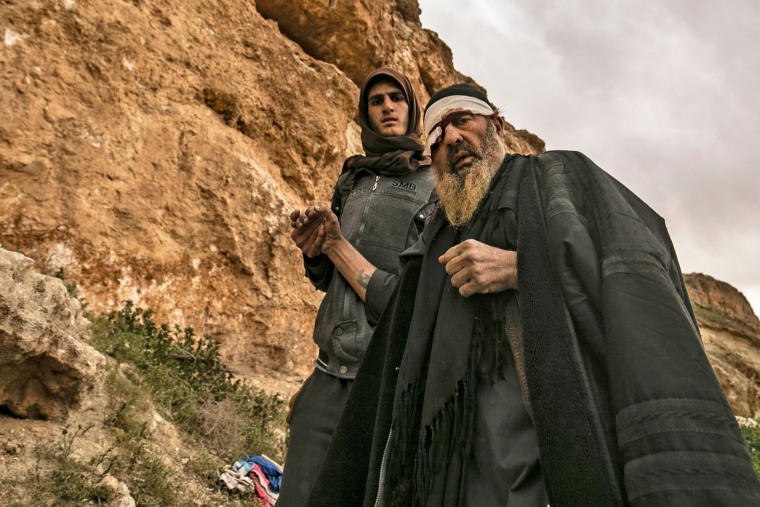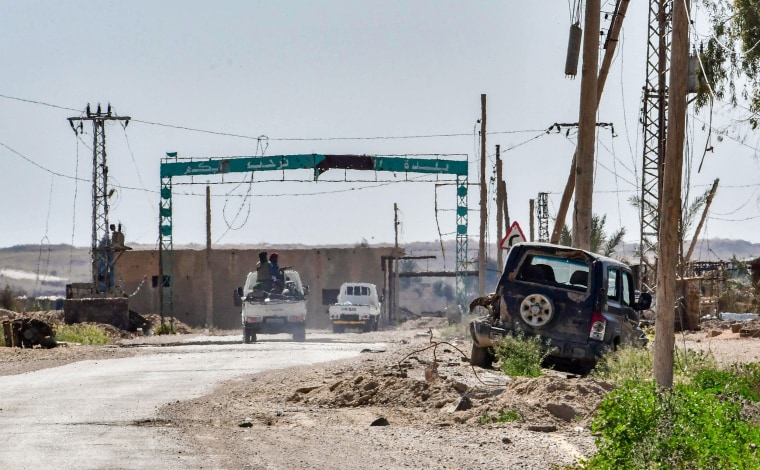BAGHOUZ, Syria — The sound of airstrikes and gunfire could be heard near the last enclave of the Islamic State group Friday night, less than an hour after the White House declared victory over the militants.
The battle for Baghouz, the group's last holdout and all that remained of the vast territory that it once ruled in Syria and Iraq, had dragged on for more than 10 weeks — far longer than either the U.S. military or their allies on the ground had predicted.
Still, President Donald Trump had been teasing the victory for days.
On Friday, the White House said the Department of Defense had declared that the militant group no longer held any territory in Syria. At around the same time, Trump tweeted that there was "nothing to admire" about ISIS.
The Pentagon did not immediately respond to a request for comment.
The militants, meanwhile, have been putting up a desperate fight, and the American-backed Syrian Democratic Forces supported by U.S.-led coalition airstrikes have held off declaring victory.
"Heavy fighting continues around mount Baghouz right now to finish off whatever remains of ISIS," Mustafa Bali, head of the SDF's media office, announced on Twitter Friday night.
Three U.S. military officials said fighting is still ongoing in Syria, and that there could still be a couple of hundred fighters there in hiding.
Tunnels are of particular concern to the Kurdish-led forces. Dug in fields and under abandoned homes, they provide invaluable hiding places for ISIS militants trying to avoid drone surveillance. The group has used such tunnels to great effect in almost every battle.
Women and children also present a unique challenge. SDF forces have repeatedly paused their offensive, sometimes for weeks at a time, to allow fighters and their families to surrender and leave the camp through a humanitarian corridor.
NBC News recently observed SDF fighters armed with AK-47s talking to ISIS members as women, children and elderly men began hiking along the base of a cliff overlooking Baghouz.

The people filing out were dirty. Many were visibly injured and limping on makeshift crutches. Others were bleeding and wincing in pain.
A young girl wearing a niqab — a veil worn by the most conservative Muslim women in which, at most, only the eyes show — cried out in pain as a woman carried her along the trail before putting her in a wheelchair. Her jeans were torn, exposing tiny legs streaked with blood.
The sheer number who emerged — almost 30,000 since early January, according to Kurdish officials — have taken the SDF and others by surprise.
A report issued by the United Nations' population fund, the UNFPA, said Thursday "it is estimated that around 7,000 people are still inside" Baghouz, without elaborating.
When asked in Arabic how many people were left inside the camp, some of the surrendering people responded in a cacophony of foreign languages: Turkish, Uzbek and others that were incomprehensible.
One exhausted-looking elderly man responded that there were "many" people left in the camp, including women and children.
Uniformed and armed SDF fighters stood sentry along the trail. At one point, the trail wound up the cliffside, forcing surrendering families to climb the cliff by gripping an exposed pipe.
Left behind were dozens of strollers, wheelchairs and pieces of luggage — items that the evacuees couldn’t carry up the side of the cliff.
Most of the surrendering people were women in niqabs. As they tried to climb the steep cliff out of the Euphrates River valley, female SDF fighters reached out to assist them.
When female fighters weren't on hand, male fighters reached out to pull them up with a piece of a wheelchair, giving them an assist while avoiding actually touching their hands.
Instead, fighters are still engaged in "clearing" or "combing" efforts in the tiny pocket where ISIS fighters and their families are thought to remain in a narrow band on the banks of the Euphrates River.
But the actual fighting, along with the sound of gunfire, artillery and airstrikes launched by the U.S.-led coalition, had all but ceased this week. In and around Baghouz itself, SDF fighters could be seen strolling past bombed-out pickup trucks, and huge craters left both by artillery and tunnel entrances.
But questions loom even if the caliphate has been finally defeated.
The extremist fighters remain a threat even if they no longer control territory, operating in remote areas elsewhere and capable of mounting attacks.
And in December, Trump declared that "we have won against ISIS" and that he would pull all of the 2,000 or so U.S. troops from the country, an announcement that surprised U.S. allies and senior military officials and plunged the U.S.-led campaign against ISIS into turmoil.
Last month, the White House said that about 200 U.S. troops will remain in Syria after the withdrawal of most U.S. forces.


